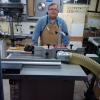I'm on the verge of buying a different band saw. I have a Delta 14" and don't do a lot with it but have some 2x6 black cherry that I want to cut into 1x6. So far I've destroyed 6 feet of it and have 166 feet to go.
I set the Kreg fence parallel to the miter grove and then attached 2 tall feather boards to the miter grove. The boards go fine for about 1½ inches and then start to cut to the left. I just want to set up something that will allow me to just push the boards through, I have not skill at following a line.
I put a steel rule in the blade and determined that it's twisted in relation to the miter slot. I found Carter has some $50 setup tools that you affix to the blade and then I guess you adjust your fence to that angle. Seems Mickey Mouse to me, plus expensive for a ruler with a magnet deal.
I wondered if there's a way to force the blade to be parallel to the miter slot.
I'm using a ½" Wood Slicer blade from Highland Woodworking.
I'm looking at a Grizzly G0513X2BF




 Reply With Quote
Reply With Quote



